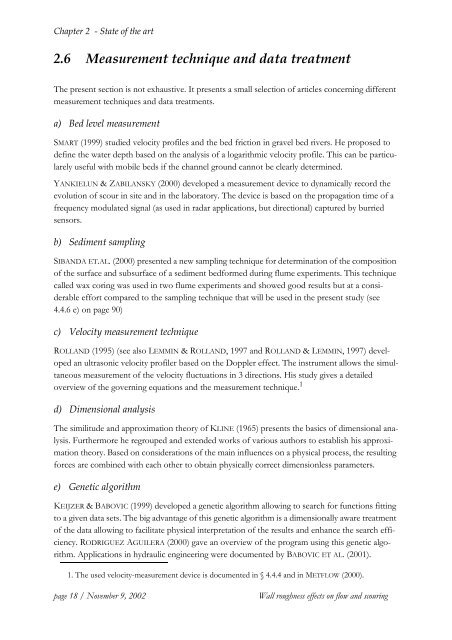pdf, 12 MiB - Infoscience - EPFL
pdf, 12 MiB - Infoscience - EPFL
pdf, 12 MiB - Infoscience - EPFL
You also want an ePaper? Increase the reach of your titles
YUMPU automatically turns print PDFs into web optimized ePapers that Google loves.
Chapter 2 - State of the art<br />
2.6 Measurement technique and data treatment<br />
The present section is not exhaustive. It presents a small selection of articles concerning different<br />
measurement techniques and data treatments.<br />
a) Bed level measurement<br />
SMART (1999) studied velocity profiles and the bed friction in gravel bed rivers. He proposed to<br />
define the water depth based on the analysis of a logarithmic velocity profile. This can be particularely<br />
useful with mobile beds if the channel ground cannot be clearly determined.<br />
YANKIELUN & ZABILANSKY (2000) developed a measurement device to dynamically record the<br />
evolution of scour in site and in the laboratory. The device is based on the propagation time of a<br />
frequency modulated signal (as used in radar applications, but directional) captured by burried<br />
sensors.<br />
b) Sediment sampling<br />
SIBANDA ET.AL. (2000) presented a new sampling technique for determination of the composition<br />
of the surface and subsurface of a sediment bedformed during flume experiments. This technique<br />
called wax coring was used in two flume experiments and showed good results but at a considerable<br />
effort compared to the sampling technique that will be used in the present study (see<br />
4.4.6 e) on page 90)<br />
c) Velocity measurement technique<br />
ROLLAND (1995) (see also LEMMIN & ROLLAND, 1997 and ROLLAND & LEMMIN, 1997) developed<br />
an ultrasonic velocity profiler based on the Doppler effect. The instrument allows the simultaneous<br />
measurement of the velocity fluctuations in 3 directions. His study gives a detailed<br />
overview of the governing equations and the measurement technique. 1<br />
d) Dimensional analysis<br />
The similitude and approximation theory of KLINE (1965) presents the basics of dimensional analysis.<br />
Furthermore he regrouped and extended works of various authors to establish his approximation<br />
theory. Based on considerations of the main influences on a physical process, the resulting<br />
forces are combined with each other to obtain physically correct dimensionless parameters.<br />
e) Genetic algorithm<br />
KEIJZER & BABOVIC (1999) developed a genetic algorithm allowing to search for functions fitting<br />
to a given data sets. The big advantage of this genetic algorithm is a dimensionally aware treatment<br />
of the data allowing to facilitate physical interpretation of the results and enhance the search efficiency.<br />
RODRIGUEZ AGUILERA (2000) gave an overview of the program using this genetic algorithm.<br />
Applications in hydraulic engineering were documented by BABOVIC ET AL. (2001).<br />
1. The used velocity-measurement device is documented in § 4.4.4 and in METFLOW (2000).<br />
page 18 / November 9, 2002<br />
Wall roughness effects on flow and scouring
















